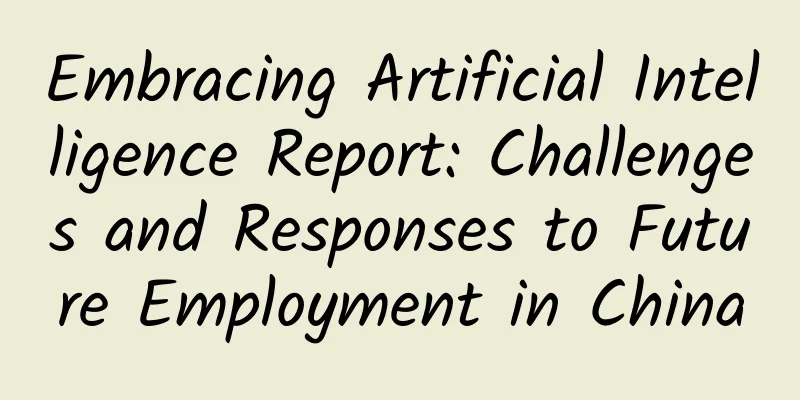Embracing Artificial Intelligence Report: Challenges and Responses to Future Employment in China

|
Recently, the China Development Research Foundation and Sequoia Capital China Fund jointly released a research report titled "Investing in Human Capital, Embracing Artificial Intelligence: Challenges and Responses to China's Future Employment". In this report, the research team compared China and foreign countries, investigated first-line companies, and visited major manufacturing provinces such as Guangdong, Jiangsu and Zhejiang. Combining theory with practice, the research team specifically analyzed the possible impact of artificial intelligence on China's employment and put forward development suggestions. The second chapter of "Investing in Human Capital, Embracing Artificial Intelligence: Challenges and Responses to Future Employment in China" compares the development level and characteristics of artificial intelligence in China and abroad. The research team compared the level and characteristics of artificial intelligence development in China and the world vertically and horizontally from five aspects: scientific research output, talent pool, core technology, key hardware and components, industrial layout, and industrial investment and financing. In a nutshell, although my country's artificial intelligence technology has developed rapidly in recent years, there is still a gap compared with developed countries represented by the United States. The third chapter of the report compares the AI industry policies of China and other countries. The research team highlighted the United States, the United Kingdom, Germany and the European Union as international comparative research objects, pointing out that these countries and regions have listed the development of AI technology as a strategic development goal and have invested huge financial resources to support the development of AI technology. At the same time, my country has intensively introduced policies to support the development of AI in recent years, such as tax incentives and financial support for AI-related companies. AI was mentioned in the government work reports for two consecutive years in 2017 and 2018, which shows the determination of the Chinese government to elevate AI to a national strategy. Chapter 4 of the report theoretically analyzes the possible impact of artificial intelligence on employment. The research team uses history as a mirror, based on the phenomenon of specialized division of labor that began with the steam revolution, and combined with general economic principles and actual conditions, to theoretically analyze the potential impact of the development of artificial intelligence technology on employment. Specifically, the impact of artificial intelligence on employment varies from industry to industry. While artificial intelligence replaces repetitive and highly programmed jobs, it will also have a positive impact on expanding demand for jobs and creating jobs. Chapter 5 of the report, which is also the focus of the report, discusses the possible impact of artificial intelligence on China's future employment. The research team discusses the possible impact of artificial intelligence on future employment from a macro perspective and an industrial perspective, including both positive and negative impacts. From a macro perspective, the development of artificial intelligence will have an impact on the economic and social structure (industrial structure, urbanization, aging and low birth rate) and the labor employment structure. On the whole, the rise of artificial intelligence is a rare opportunity for China. Even if we encounter some challenges, we should actively embrace it instead of being afraid of it, just like we did when we "joined the WTO". The research team also visited traditional manufacturing provinces such as Guangdong, Jiangsu and Zhejiang to study the situation of "machine replacing people". The investigation concluded that the relevant technologies of artificial intelligence have penetrated into all aspects of the manufacturing industry; from production, circulation to sales, they are becoming more and more data-based and intelligent, and the replacement of labor by industrial automation and intelligence has reached a considerable scale and speed. From the perspective of different industries, the research team focused on five industries, namely retail services, financial services, education services, medical services, and transportation and logistics, and discussed the impact of artificial intelligence on these industries through data analysis, case analysis, etc. The report pointed out that artificial intelligence technology can reduce the unit operating costs of these industries and improve the operating efficiency of enterprises. At the end of this chapter, the report quotes Chen Yongwei’s report, which lists the probability of each occupation being replaced by artificial intelligence in the next 20 years. The last two chapters of the report point out the challenges that China may encounter in developing artificial intelligence technology in education and social security, as well as suggestions for the development of artificial intelligence in our country. The PDF version will be shared to the 199IT exchange group. If you want to support our development, please join us! |
Recommend
Case analysis: The confusion of an O2O product manager!
The theory is boring. After reading it, I just fe...
Are wild tigers frequently entering villages? In fact, there are far more captive tigers than wild ones
Editor’s Note: On November 18, 2024, a tiger appe...
Google open-sources a “poor man’s version” summary generation NLP model: 1,000 samples can beat humans
This article is reprinted with permission from AI...
In-depth analysis of banner, interstitial, and interactive advertising performance
Today, Qingguajun will explain banners, interstit...
Short videos put an end to the era of unlicensed operation. The industry under supervision must exercise self-discipline
Recently, the State Administration of Radio, Film ...
Experts comment on the competition for super TVs: LeTV competes openly with Konka and secretly with Tencent
On March 18, the Internet smart TV "T60 Supe...
5.81 million people participated in Tencent’s “Children’s Gallery” charity event. From being popular to being questioned, why was it so popular?
On the morning of August 29, the WeChat Moments w...
Methods and strategies for new media operations to follow hot topics!
Is it useful to follow hot topics? In this articl...
APP operation: Can the revenue from application push be increased by 400%?
Push is the most cost-effective and direct market...
Lichens, mosses, these "tiny miracles" of nature - how to distinguish them?
Some people with professional knowledge feel that...
Banzong's special course - Banzong teaches you how to make ultra-short 3 PDF
Banzong's special course - Banzong teaches yo...
How to do advertising and marketing? Don't be too rational!
In our daily lives, seemingly rational consumptio...
Be careful when reading long and informative articles! ASO optimization experience: Tips for APP keyword optimization
For your product, choosing the right keywords for...
Snakes also like to take hot spring baths
In ancient times, the Qinghai-Tibet Plateau was a...









